
[ad_1]

Pakistan has 1046 kilometres of coastline along the Arabian Sea, having several big and small ports in its coastal region.
Some of the important ports of Pakistan are Karachi port, Muhammad Bin Qasim port, and the Gwadar Port.
The Gwadar port is one of the deepest seaports in the world and holds great importance because of its strategic location.
The Karachi port is the busiest port of Pakistan and is considered the economic hub of Pakistan.
Let’s take a look at some of the major ports of Pakistan in this article.
1. Karachi Port & Harbour
Karachi, Sindh Province
UN/Locode: PK KHI
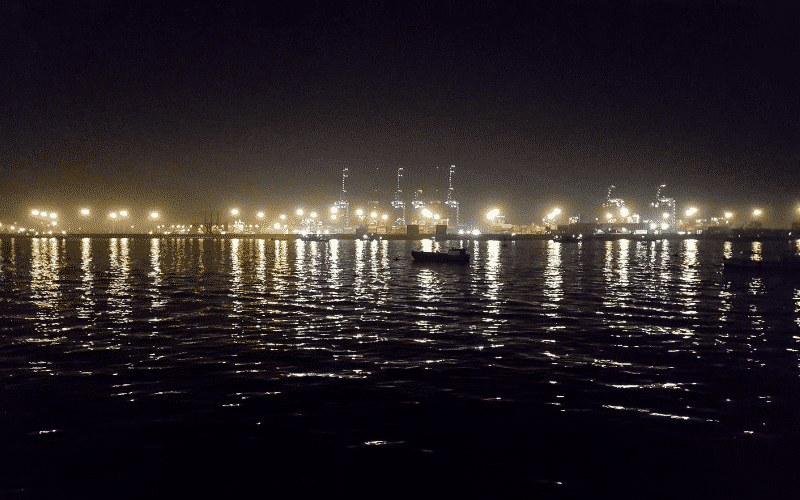
The Bandar gāh Karāchī is a large deep-sea port operated along with the Arabian Sea coast of Pakistan. Owned by the Ministry of Maritime Affairs and managed by the Karachi Port Trust (KPT), it handles nearly 60% of national shipments.
Karachi Port is a natural harbour that has been operational since the early 18th century although ancient ports were operated by the local rulers since the 8th century CE. Today, the port sits on 32 kilometres of wharves and docks. The anchorage depth is 16 metres with 41 berths and 8 wharves available for commercial vessels.
Karachi became an important port under British rule and was home to newly developed facilities used to improve trade. The modern harbour was opened in 1854 off the Pakistan coast but has gradually been integrated into the mainland by way of causeways and bridges. A major reason for the importance of Karachi is its proximity to the Straits of Hormuz and the Suez Canal.
The port boasts of an annual 65.25 million tons of cargo and 1.56 million TEUs. The port is constructed with an 11 km channel for incoming vessels and 2 zones for berthing- the West and East wharves.
With a maximum capacity of 75,000 DWT for docking vessels, the wharves comprise 3 liquid cargo berths, shipyards and repair sites, 2 dry docks, and 3 container terminals.
Karachi International Container Terminal (KICT) on the West wharf is capable of handling Panamax and Post-Panamax vessels along 600 metres of berthing space. The Pakistan International Bult Terminal (PIBT) on the East wharf can process Panamax vessels with an annual capacity of 350,000 TEUs.
The Al-Hamd International Container Terminal (AICT) operates nearby on the Layari river and does not strictly fall under the port premises. The Harbour also has space for naval and commercial shipbuilding and repair. The facilities include dry docks, construction complexes, steel handling plants, and outfitting zones spread over 70 acres.
The severe congestion at Karachi Port has led to the construction and development of neighbouring ports such as the Pakistan International Container Terminal, Gwadar Port, and Port Qasim. Korangi Fishing Harbour has been designated to ease the pressure off the Karachi Fishing Harbour, while Ormara Naval Base has taken on naval vessels to free docking space at Karachi.
Expansionary projects to improve the port include enhanced TEU handling capacities at KICT and PIBT, a new bulk cargo terminal, construction of a new passenger terminal, and reconstruction of facilities to decrease vessel Turn Around Time (TAT).
2. Gwadar Port
Gwadar, Balochistan Province
UN/Locode: PK GWD
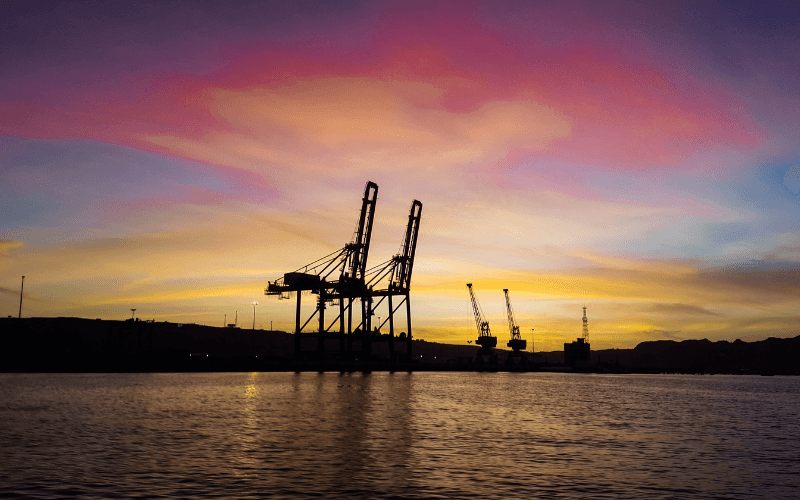
The Bandar gāh Gwadar is a major port on the Arabian Sea under the administration of the Gwadar Port Authority. The China Overseas Port Holding Company has operational and executive control of the port. Gwadar is a major player in Pakistan-Afghanistan trade transit and is a hub of the proposed China-Pakistan Economic Corridor (CPEC). Under these initiatives, the harbour is linked to the Maritime Silk Road and Belt & Road Projects.
Located near Chabahar Port in Iran and close to the Gulf of Oman and Straits of Hormuz, Gwadar is a deep-sea port and has been operational since 2016. It is still under expansionary activities planned in 3 subsequent phases. The port features a floating liquefied natural gas facility, the Gwadar Special Economic Zone, and a dedicated facility to promote CPEC interests.
The current annual container capacity as of 2018 is 30 million TEUs. The proposed cargo capacity is 400 million tons by 2045 against a current capacity of 11 million tons. The expansion phases are set in 3 stages with delivery in 2029 and 2045 for the pending 2 stages. The proposed ship classes to be supported are:
1. Bulk carriers – 30,000 DWT
2. Panamax – 52,000 DWT
3. Neo Panamax – 200,000 DWT
4. Chinamax – 400,000 DWT
5. Valemax – 400,000 DWT
6. TI-Class Supertankers – 440,000 DWT
The harbour will be linked to the Khunjerab Railway for commuting with surrounding industrial hubs. The Iran-India bilateral expansion of Port Chabahar is likely to develop the Gwadar-Chabahar region and lead to transhipment facilities at both ports.
3. Port Muhammad Bin Qasim
Bin Qasim, Malir District, Sindh Province
UN/Locode: PK BQM
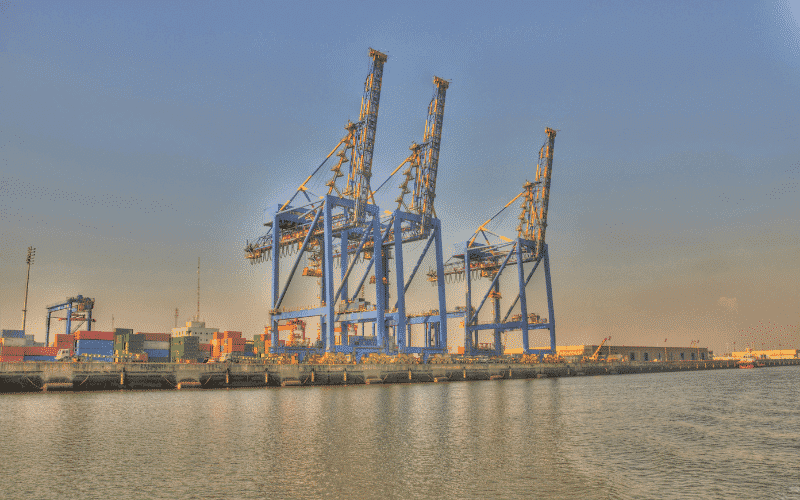
The Bandar gāh Muhammad bin Qāsim is the second largest port in Pakistan and in the top 150 ports of the world. It is a deep-sea port constructed in an artificial harbour of the Sindh Province.
Owned by the Maritime Affairs Ministry, Port Qasim has been operational since 1980 and sits on 50 square kilometres. The operating body is the governmental Port Qasim Authority (PQA).
It handles roughly 35% of the total maritime trade through Pakistan, has over 1,500 port calls annually, a container volume of 700,000 TEUs, and an annual cargo tonnage of 16.6 million tons. The harbour has a tidal variation of 3 metres and can berth vessels in the 75,000 DWT range as of 2008.
Port Qasim is linked to the Korangi Industrial Area, Landhi Export Processing Zone, and several automobile manufacturing industries. It is in close proximity to Port Karachi and lies on the Indus River.
The port is very well connected to the road, rail, and inland waterways. The National Highway, Jinnah International Airport, and Indus connectivity routes are within a 20 km radius from the harbour.
The harbour is classified into 3 main zones for administrative ease:
1. North Western Industrial Zone (NWIZ) – 2,920 acres
2. South Western Industrial Zone (SWIZ) – 1,000 acres
3. Eastern Industrial Zone (EIZ) – 8,300 acres
The main facilities available to berthed ships at Port Qasim are:
1. 4 berth Multipurpose Terminal under PQA
2. 5 berth Container Terminal under Qasim International Container Terminal (QICT)
3. Single berth Liquid Chemical Terminal under Engro Vopak Ltd.
4. Single berth Oil Terminal under Fotco Oil Terminal
Future expansionary projects lined up for Port Qasim include advanced facilities such as additional liquid cargo terminals, container terminals, oil terminals, and a steel jetty.
There are also plans to construct coal & clinker processing units, a Granada LNG unit, and a GasPort LNG Floating Terminal. Lastly, development of the road and rail facilities, expansion of the infrastructure in EIZ, and a textile city to support local industries.
A new joint initiative between Pakistan Customs and the US Customs and Border Protection forces is an Integrated Cargo-Contained Control Facility (IC3) that will screen US-bound shipments at Port Qasim to improve maritime trade security and reduce risk to these goods prior to reaching US ports.
4. Mohammad Ali Jinnah Naval Base
Ormara, Balochistan Province
UN/Locode: Unspecified
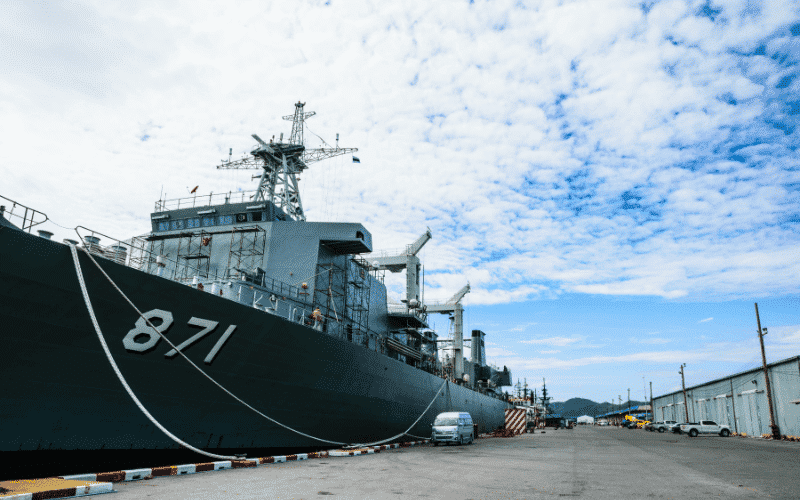
The Jinnah Bāhrī Māsthar is Pakistan’s premier Naval Base and the second largest in the country. Owned and operated exclusively by the Pakistan Navy, it is home to the primary operational base.
Situated on the Makran Coastal Highway in the Balochistan Province, it is located 240 kms to the West of Karachi Port Harbour and Gwadar Port.
Staffed by the Ministry of Defence, the Jinnah Base was built away from international territory is exclusively Pakistani waters. The construction was undertaken by several organizations based out of Pakistan, Belgium, and Turkey. The final contract was executed by STFA and STM (Turkey), Jan De Nul (Belgium), and FWO and MES (Pakistan). Following 6 years of construction and outfitting, the naval base was commissioned in 2000.
The Port boasts world-class facilities to berth and service naval vessels. With berths for warships, submarines, and other naval assets, the port is a major hub for shipbuilding and maintenance activities.
Working in tandem with the Karachi Naval Dockyard and the Karachi Naval Shipyard, Jinnah Naval Base is an important site for the maritime branch of the Pakistan armed forces. It has the unique distinction of being the sole forward base for the entire fleet of diesel-electric submarines operated by the Navy.
At present, the port is capable of servicing up to 8 warships and 4 submarines simultaneously. A Cadet College operated in Ormara also serves to train and develop future officers of the Navy.
5. Keti Bander Port
Thatta District, Sindh Province
UN/Locode: PK KBA
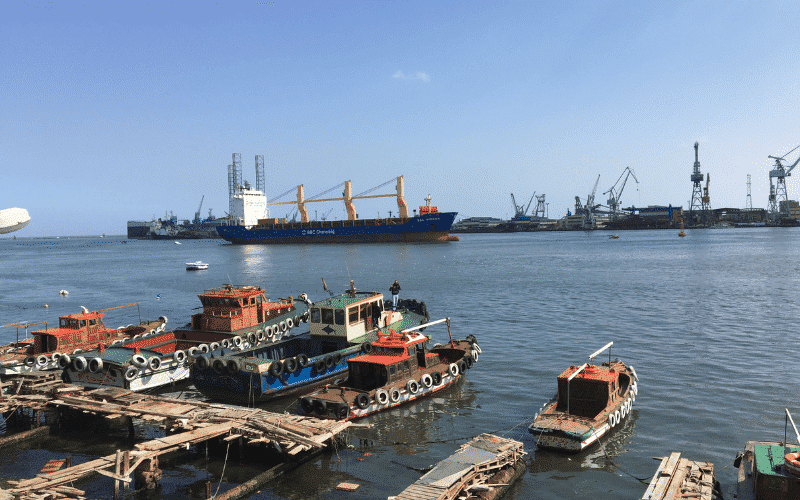
The Keti Bander/Bandar Port of Pakistan is one of the oldest ports in the country and a small harbour that supports the local economy. Situated in the Thatta District and within 4 hours from Karachi by road, Keti is an extension of the ancient port of Debal near Manora Island.
The modern-day port is situated on the river Indus and is a hub predominantly owing to its location near the Arabian Sea and the Hajamrao river.
The primary purpose of Port Keti is as a fishing harbour for the districts of Mansura and Thatta. In peak seasons, fish shipments from Keti Bandar to the larger ports for subsequent repackaging and export is common.
The surrounding hinterlands are almost entirely dependent on the port and its fishing activities. Catches of the day are auctioned and sold at quayside markets where produce from the Arabian Sea is highly prized. Karachi is the largest destination where these fish are sent for exports.
6. Port of Ormara
Gwadar District, Balochistan Province
UN/Locode: PK ORW
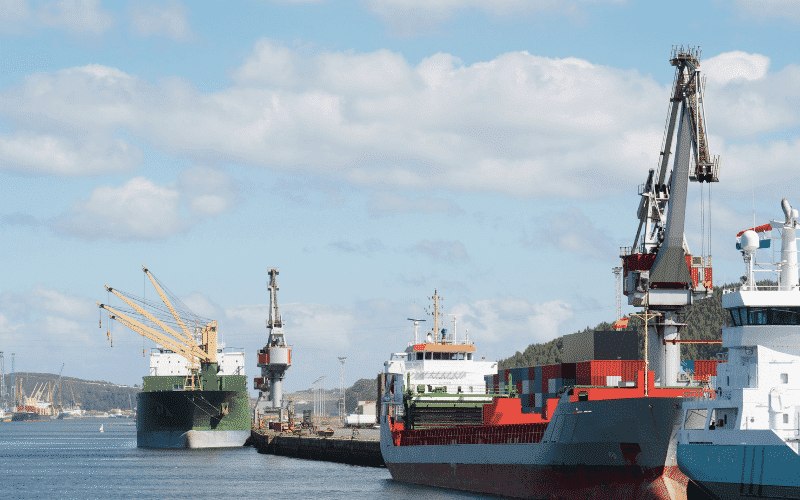
The Bandar-gāh Ormara is a prominent harbour lying on the Makran Coast in Pakistan and situated between the Karachi and Gwadar Ports. Its maritime significance dates back to 40 – 70 A.D. in ancient trade and maritime logbook (the Periplus of the Erythraean Sea).
Functional since the times of Alexander the Great, Ormara has been an important strategic location as it provides access to and control of the Indus region. Today, it comes under the Makran division of the Government of Pakistan and has seen a decline in the prosperity of the port and the surrounding hinterlands due to the advent of the nearby harbours.
The port predominantly deals with fishing and ships fresh produce to larger harbours in Pakistan for repackaging and subsequent export. The Makran Coastal Highway Project, known as National Highway 10, extends along the Arabian Sea coastline of Pakistan and has revitalized the port and brought in much-needed facilities. This has linked the port to the larger National Highway system and allows passage of goods and cargo through Ormara.
The Jinnah Naval Base is located in Ormara and is the 2nd largest naval base in the country. It was jointly constructed by Belgium and Turkey on behalf of the Ministry of Defence and has increased economic activity in the region, with the fish port receiving new equipment to increase the output of fresh produce for export around the world.
Moreover, since the Pakistan Navy’s key military assets (including submarines and nuclear warheads) are located at Ormara, the hinterlands have been developed to accommodate its needs. The nearby Cadet College has helped in boosting the finances of the port, and the government plans to revitalize the Ormara coastline by 2030 to convert the naval base into a thriving strategic hub.
7. Port of Pasni
Pasni, Gwadar District, Balochistan Province
UN/Locode: PK PSI
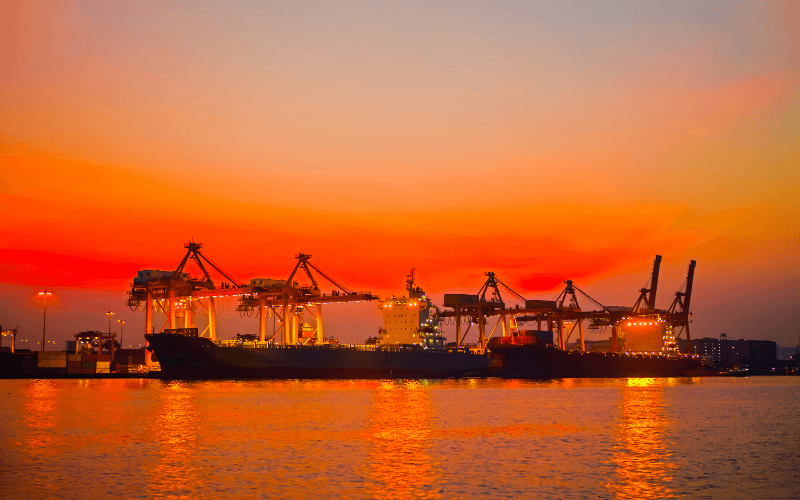
The Bandar-gāh Pasni located in Balochistan is a medium seaport, fishing harbour, and naval base on the Makran Coast. The primary source of economy for the surrounding hinterlands is fishing, which contributes to traffic at Pasni.
As the land is not arable, the port also handles shipments from other Pakistani Ports to supplement food and other products for the locals. The fishing harbour is modern and features state-of-the-art facilities to process and package produce for export.
A significant portion of the export shipments from Pasni is destined for Turbat (Kech District, Balochistan Province) and Karachi. The operating authority is the Government of Balochistan Port Authority (BPA) and the harbour is owned by the Maritime Affairs Secretary of Pakistan.
The Pasni Port is part of a fisheries department study in the region of Balochistan and Sindh. These regions are major export hubs, and this port is no exception.
The catch is usually processed in the port premises, packaged for export, and sent to the numerous fishing harbours at Karachi Port. Here, the facilities meet requirements for export to EU countries, and the produce is repackaged for international export.
The port is well connected by road and air to the major cities of Pakistan. The Naval Base in Pasni is a hub of activity that has resulted in the development of the nearby Pasni Airport and the National Highways. The attached Airport jointly houses operations for the Pakistan Navy, the Air Force, and civil aviation terminals.
The regulatory authority for matters pertaining to fishing and harbour activities falls under the Balochistan Sea Fisheries Act, 1971 and is intended to protect marine life and the livelihood of the locals.
8. Port of Jiwani
Jiwani, Gwadar District, Balochistan Province
UN/Locode: PK JIW
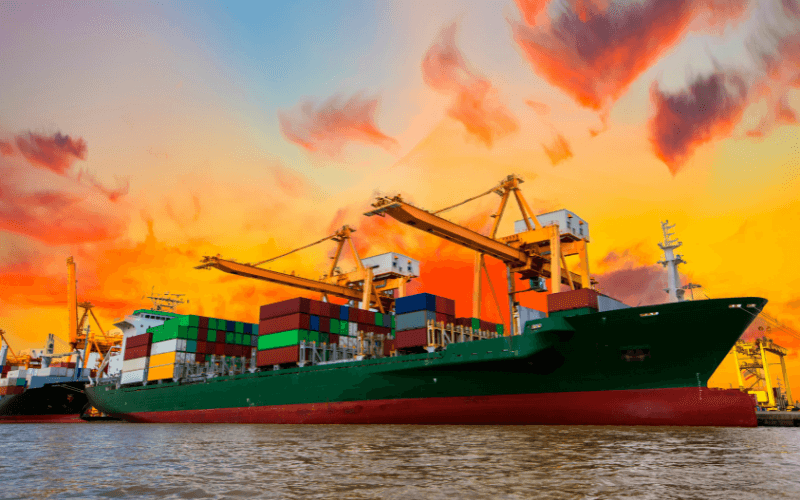
The Port of Jiwani located on the Western extent of Pakistan is a naval and commercial harbour situated along the Gulf of Oman. It lies near the ports of Gwadar, Pakistan (60 kilometres East) and Chabahar, Iran (110 kilometres West).
Its close proximity to these shipping hubs has led to the development of Jiwani and the surrounding hinterlands. It is well connected to major cities via the Makran Highway (to Karachi) and the Jiwani Military Airport which is used to transport fresh produce.
Based in Gwadar Bay, Port Jiwani holds immense importance from a naval point of view. It lies close to the Straits of Hormuz, the Persian Gulf, and the Gulf of Oman; all of which are prominent shipping routes.
The Pakistan Naval Base located in the harbour also has an airstrip for the Pakistan Air Force. At present, China is in talks to set up a base at Jiwani to supplement their maritime presence using bases in foreign countries. Jiwani will be the second of the Chinese Naval Bases situated in Pakistan (Gwadar being the other). During World War 2, Jiwani was a major Allied base for both the Allied Navy and Air Force.
There are plans to set up offshore drilling units and ramp up the fishing facilities in the harbour in an effort to inject foreign investment (FDI). The existing facilities include fish freezing plants near the port harbour. The locals are mainly dependent on the sale of fish products to larger cities for export abroad.
Additional mention:
Gadani Harbour & Ship Breaking Yard
Gadani, Balochistan Province
UN/Locode: Unspecified
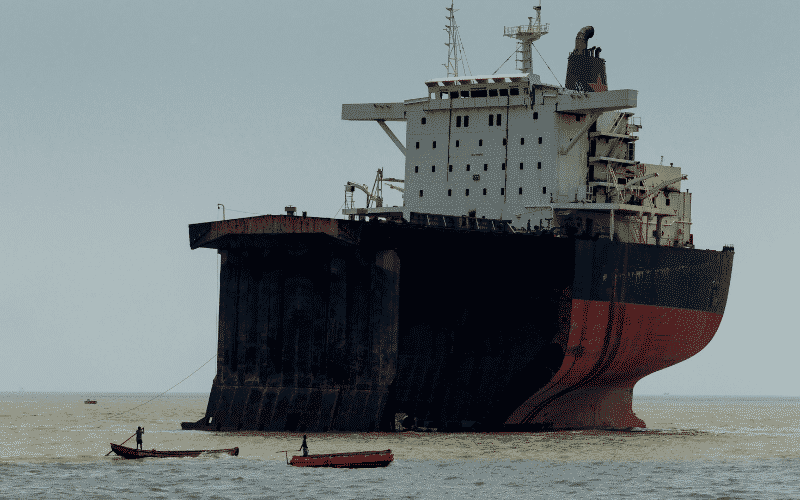
The harbour at Gadani is an important global hub for ship breaking and scraping. Spread across 10 kilometres on the Arabian Sea and close to Karachi Port, Gadani is the third-largest ship-breaking yard in the world. It directly competes with other yards in Alang (India), Chittagong (Bangladesh), and Aliağa (Turkey).
Gadani currently employs around 6,000 workers and staff to scrap an annual tonnage of nearly 1 billion tons. In 2009-10, 107 ships were broken, a record in itself. There was a combined Light Displacement (LDT) of over 850,000 tons scrapped, an improvement of 7% over the preceding year.
The current harbour capacity is breaking 125 ships annually with DWT up to 1,000,000 DWT (supertankers). Gadani is the most efficient ship-breaking yard with a capacity of breaking vessels at over 3 times the speed at Alang and Chittagong.
Scrapping is a prominent activity in Gadani, and the Government of Pakistan revitalized it by reducing taxes and duties by 5% to incentivize workers and ship owners to prefer Gadani over competing facilities.
Disclaimer: The authors’ views expressed in this article do not necessarily reflect the views of Marine Insight. Data and charts, if used, in the article have been sourced from available information and have not been authenticated by any statutory authority. The author and Marine Insight do not claim it to be accurate nor accept any responsibility for the same. The views constitute only the opinions and do not constitute any guidelines or recommendations on any course of action to be followed by the reader.
The article or images cannot be reproduced, copied, shared or used in any form without the permission of the author and Marine Insight.
8 Major Ports In Pakistan appeared first on Marine Insight – The Maritime Industry Guide
[ad_2]
This article has been posted as is from Source